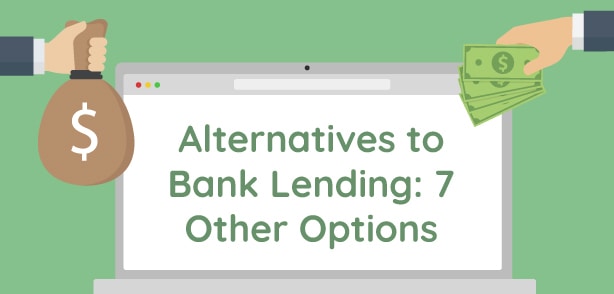The Top 7 Bank Lending Alternatives to Consider

All businesses need access to additional working capital. The ideal means of obtaining capital is through a business’s core operations that generate revenue.
When a business earns a profit, some or all of that profit can be put back into the business to ensure growth.
However, sometimes businesses will require additional financing from a reputable lender. Many business owners turn to banks to secure financing. However, banks aren’t the only financing solution available to business owners.
In this article, we’ll discuss seven bank lending alternatives, so that you’re aware of other viable funding options.
7 Small Business Lending Alternatives
Bank loans are a common financial product utilized by small business owners. Yet, banks often have stricter lending policies than alternative lenders. Due to this, small business owners find it difficult to obtain crucial business loans from banks.
Luckily, traditional bank loans aren’t the only financing source that business owners can pursue. Below, you’ll find a list of notable financial alternatives to traditional lending:
1. Business Lines of Credit
A line of credit (LOC) is a set amount of money that a business can use when it needs cash. It can be either secured or unsecured.
A secured line of credit requires some collateral, whereas an unsecured loan doesn’t. Once the amount borrowed from the LOC is paid off, It frees up the amount to be used in the future.
Pros and Cons of Lines of Credit
Pros
Flexible financing option that reduces cash flow shortages
Can help businesses predict their future operational cycles
Cons
The interest rates can be high in some cases
Businesses may rely on the LOC too much, causing them to overextend
2. Merchant Cash Advances
With a revenue advance, a business owner receives lump sum financing in exchange for a percentage of their future credit card sales. If you receive consistent credit card payments, you’re likely a great candidate for this product.
Pros and Cons of Merchant Cash Advances
Pros
Payments aren’t fixed, so the weekly or monthly payments are based on your business’s credit card sales at that time
Fast financing option
Payments are taken directly from your account, reducing the chance of late fees
Cons
The rates can be high
If you don't receive consistent credit card sales, this option won't work for you
3. Working Capital Loan
A loan that's used to fund a company’s core operations is known as a working capital loan.
Day-to-day operations can cause financial hardship if a company doesn’t have the funds to maintain them. This frequently occurs with seasonal businesses or companies that are subject to cyclical sales. Still, businesses in various industries can experience working capital shortfalls from time to time.
A working capital loan isn’t a specific loan type, but more of a category of loans. Any loan that helps a business meet short-term operational obligations could be considered a working capital loan including lines of credit, term loans, and invoice financing.
Pros and Cons of Working Capital Loans
Pros
Business owners can retain equity in their businesses
Usually, collateral isn't required, but the terms are subject to your business lender's requirements.
Cons
If you don't pay off your balance during the set term, it could affect your business’s credit rating. That's why it's important to evaluate your cash flow during the life of the loan.
If collateral is required, it could put your collateral assets at risk.
4. Equipment Loans
Many businesses require equipment to operate; therefore, if that equipment fails, it can derail the business. Unfortunately, many small businesses lack the capital required to maintain equipment.
Because the equipment serves as collateral, owners can often get financing for a large percentage of the equipment cost equipment since it's a secured loan.
Pros and Cons of Equipment Loans
Pros
Equipment loans are secured, making them easier to obtain
Equipment loans often come with low rates. However, it's important to read the terms and conditions prior to committing to an equipment loan.
Cons
Many lenders require a significant down payment for this type of loan.
When equipment becomes obsolete, it may be difficult to receive any tangible value from it.

5. Professional Practice Loan
Professional practice loans are a class of specialty loans for medical, legal, and accounting professionals. Most of these loans are for medical practitioners, as their financing needs are often greater due to the cost of medical equipment.
The loans could be used for initial equipment purchases or acquiring other professional practices. Consolidating debt and expanding operations with real estate are other possible uses for this type of funding. For medical practitioners, it may even include malpractice insurance costs.
Pros and Cons of Professional Practice Loans
Pros
Rates are attractive, as professional services businesses have low default rates.
Lenders specializing in professional practice loans tend to understand the risks associated with them.
Cons
Practitioners may spend too much of the loan amount on non-core functions, causing the core business to suffer when it needs a capital infusion
As technology improves, past equipment becomes obsolete. Practitioners may find themselves upgrading too frequently, requiring more funding.
6. Invoice Factoring
Invoice factoring is one of the oldest forms of business financing, but many business owners aren’t aware of this option, despite its long history.
A factoring company will agree to buy the receivables generated by invoices. In this way, factoring isn’t considered a loan; it’s a transfer of assets. The factor pays a discounted cash amount based on the value of the receivables, and often takes a role in the collection on behalf of the company. This frees up the business owners, allowing them to focus on their operations.
Factoring is different than asset-based lending, where a loan is generated. With asset-based lending, the receivables are used as collateral for a loan. This affects the credit profile of the business. With factoring, as no loan is generated, the credit profile of the company remains intact.
Pros and Cons of Invoice Factoring
Pros
Business owners can often receive invoice factoring funds in a week or less.
Business owners with a poor financial history can receive funding, as the factor analyzes the risk of the business owners’ customers.
Factors often take on the role of the creditor on behalf of the business.
Cons
It’s one of the more expensive business funding options available to business owners.
Factors will be involved with the day-to-day operations of the business.
7. Franchise Startup Loan
A franchise is a business form that helps people who want to go into business, but don’t want to start from scratch. A franchise helps by allowing these people to piggyback on the success of a well-known brand. A company whose operating model is primarily a franchise (franchisor), lends support to those accepted into the franchise (franchisee).
The franchisee is often required to raise capital to cover the cost of the franchise fee. However, the franchisor may have financing options available to help the franchisee with this requirement. Even with this help, however, a potential franchisee may need to put up some capital in the process.
Pros and Cons of Franchise Startup Loans
Pros
The franchise is often an established brand, which helps in the funding decision.
Franchises are usually based on proven formulas, which put the odds of success higher than starting a business from scratch.
Cons
- Initial funding can be out of reach for many borrowers
- Capital-intensive operations will require interim funding for the replacement of critical components of the business.
Is Conventional or Alternative Financing Right for You?
Choosing the right financing option is challenging, but there are several options are available to small business owners, like the funding options mentioned in this post.
Editor’s Note: This post was updated for accuracy and comprehensiveness in October 2021.